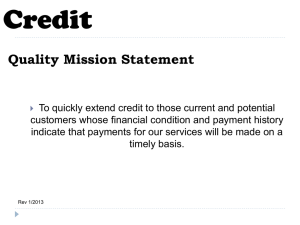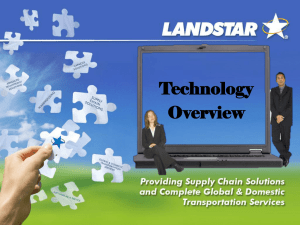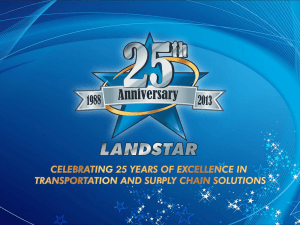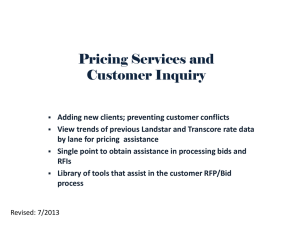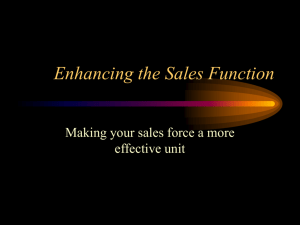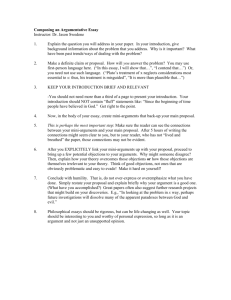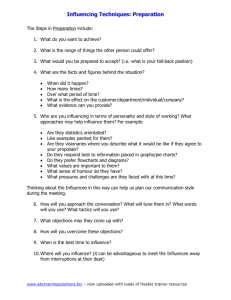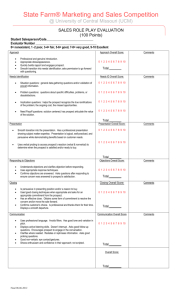Develop the Landstar Solution - USA Transportation Logistics, LLC
advertisement
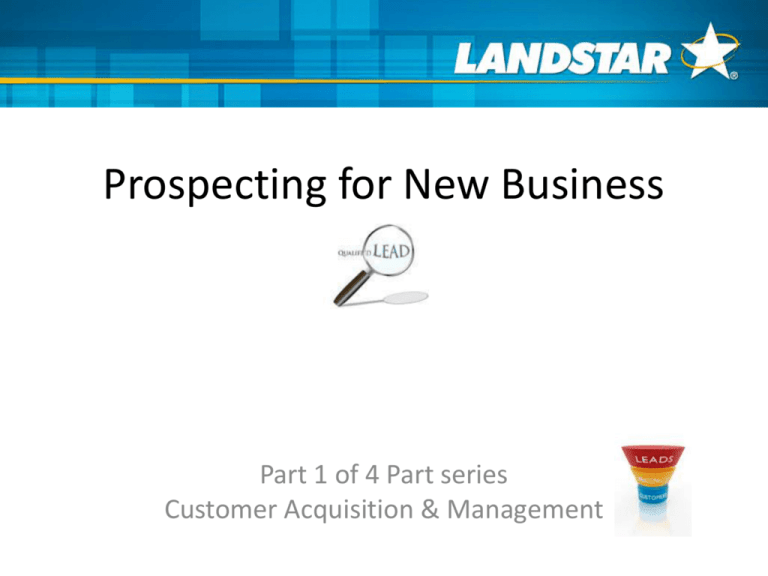
Prospecting for New Business Part 1 of 4 Part series Customer Acquisition & Management Customer Acquisition & Management Series • Prospecting for New Business • Developing the Customer Opportunity • Overcoming Objections & Developing the Landstar Solution • Customer Retention & Growth Overview/Agenda The Sales Cycle Setting Goals Finding Leads Researching Leads Getting Past the Gatekeeper Identifying the Decision Maker Call Planning ABC’s Developing your Pipeline Stay Motivated! 3 The Sales Cycle Customer Retention/Growth, Strategic Sales, Referrals Close/Implement the Solution Find & Research Leads Understanding Objectives, Call Planning Uncover Needs, Develop Solutions Setting Goals • • • • Set Goals for your activity Stay on target Repeat the sales process! Benchmark your results: – Example based on $250,000 revenue goal: $250,000 / $1611.00 (avg freight bill) = 155 loads/year or 13 loads/month or 3 loads/week! Popular Websites • • • • • • • • • www.thomasnet.com – free lead source www.salesgenie.com – must enroll www.manta.com – free lead source www.google.com www.machinerytrader.com – Heavy haul www.justsell.com – sales resource www.morebusiness.com – business resource www.referenceusa.com – go thru local library (if on own, could cost) www.truckstop.com – use ShipperMate (cost beyond Landstar subscription) Other Lead Resources • • • • • • • • • Dunn & Bradstreet (fee based) Industrial & Trade Associations Business Organizations, Chamber of Commerce Network: Who do you know past & present? Trade Shows Media – news, television, radio Industry Publications Manufacturer’s guide Competitors There are opportunities everywhere; keep your ears open and your eyes peeled! Researching Leads • Use the internet – research leads then plan your call! • Company websites – – – – – Company history Mission statement Press releases Product and service offerings Contact links like “about us” or “contact us” • Competitor websites • 3 Things you should know after research: What the company was doing, is doing, and will be doing. Getting Past the Gatekeeper Q: Who are the gatekeepers? A: Anyone or anything between you & the Decision Maker: – Receptionists, administrative assistants – Other employees – voicemail Q: How do you get past the gatekeeper? A: Any way you can!!! Getting Past the Gatekeeper • Be creative, but always remain professional & courteous • Start from the top down when asking to speak to a contact • Ask for a different department (Accounts Receivable) then ask to be transferred • If you get voicemail with a person’s name (no title or department), call back & ask for that person by name • Speak with receptionists or sales persons – they know who the decision makers are and may offer valuable inside information Identifying the Decision Maker Q: How do you find the decision maker? A: Use knowledge you gained through research and ask pertinent questions. • One method is to start from the top down – ask for the top level executive for that company. The key is to reach the highest level person possible. • Don’t start with dispatchers, but don’t discount them either – they may become your champion further into the sales process. • Know the name and title of the person to whom you are speaking and understand his/her role in the organization – in a smaller organization, the dispatch person may be the boss filling in! Identifying the Decision Maker • Understand that as you move along in the sales process you may discover: – Your initial contact wasn’t the true decisionmaker, or – Your initial contact is one of a few decisionmakers, or – Your decision-makers may vary in different business segments, or due to changes being made within their organization Call Planning • Determine your objective: What do you want to see as your end result? • Take note of known facts about the company to develop questions specific to the role of your contact, the company, or the industry Call Planning • At minimum, a good call should contain 3 components: – Acknowledgement, a – Benefit statement, and a – Commitment Acknowledgement • Short and to-the-point, professional, and courteous • Include your name and company • Include a known fact or item of interest to the potential customer If you decide to leave a voicemail, be prepared and keep it brief! Benefit Statement • Benefit statements create value for the buyer but beware – what you perceive to have value may be different from the other person on the other end! • Know the issues within the customer’s industry and learn what solutions Landstar has successfully employed to meet similar needs for other customers • Regional Sales Managers, Landstar Corporate and other agents are good resources for this information Benefit Statement • Know what’s happening that may affect your prospect or customer – new product offerings, increased production, new distribution centers or facilities • Knowledge is power! Let the person on the other end of the line know you care about developing a solution to meet their needs. Benefit Statement • If appropriate, transition into questions: – How soon will the new facility / distribution center be open? – How soon is your new product launch? – How will that impact you? Listen for verbal cues, pauses, tone of voice, etc. Listen & Learn Commitment • Know your desired outcome and ask for a commitment from your prospect or customer that will move the sales process forward – a follow up conversation, phone conference, meeting. • If your contact is busy, be prepared to offer alternative date/times – don’t be vague. If they ask, “Can you call back later?”, don’t tell them you’ll call next week. Commitment • Be specific and ask, “Will next Friday at 2pm work better for you?” • Then make a time commitment in return: “I appreciate your busy schedule and will keep it brief, no more than 15 minutes.” your time commitment should be appropriate for the nature of the action Developing a Pipeline • Pipeline is a sales term for tracking customer opportunities. It’s your record management system. • Track your sales calls. Include date, time, your contact’s full name, topic of discussion. • Make sure to take note of any lane detail, customer needs, or follow up action required Customer Pipeline • Customer Resource Management (CRM) systems are helpful – find one that works for you! Stay Motivated! • Websites: – Sign up to receive daily sales quotes, prospects, newsletters, and other sales tools at www.justsell.com – Sign up to receive “Sales Caffeine”, a weekly newsletter at www.gitomer.com • Movies: – The Pursuit of Happyness • Audio: – Over the Top – Zig Ziglar – The Psychology of Achievement – Brian Tracy Stay Motivated! • Books: – The Little Red Book of Selling – Jeffrey Gitomer – Raving Fans – Ken Blanchard – Spin Selling – Neil Rackham – What Clients Love: A Field Guide to Growing your Business – Harry Beckwith – The One Minute Sales Person – Spencer Johnson Stay Motivated! • Persistence & Good Habits Make the Difference! “Obstacles can’t stop you. Problems can’t stop you. Most of all, other people can’t stop you. Only YOU can stop YOU” – Jeffrey Gitomer Customer Acquisition & Management Series • Prospecting for New Business • Developing the Customer Opportunity • Overcoming Objections & Developing the Landstar Solution • Customer Retention & Growth Developing the Customer Opportunity Part 2 of 4 Part series Customer Acquisition & Management Customer Acquisition & Management Series • Prospecting for New Business • Developing the Customer Opportunity • Overcoming Objections & Developing the Landstar Solution • Customer Retention & Growth Overview/Agenda Review Part 1 The Sales Cycle Decision Makers in Depth The 1st Appointment Build Rapport Establish Credibility Needs Assessment Qualifying the Opportunity 30 Let’s Review! • • • • • • • • The Sales Cycle Setting Goals / Benchmarking Finding & Researching Leads Getting Past the Gatekeeper Identifying the Decision Maker Call Planning – ABC’s Tracking your sales activity – Pipeline Staying Motivated! The Sales Cycle Part 4 Customer Retention/Growth, Strategic Sales, Referrals Find & Research Leads Part 1 Part 1 Close/Implement the Solution Understanding Objectives, Call Planning Part 3 Uncover Needs, Develop Solutions Parts 2 & 3 Hierarchy of Decision Makers CEO, • Vary by industry, size of President, organization or the business Executive segment within the Level organization. • Hierarchy of decision makers VP & Director Level is universal. • Always try to reach the highest level contact Managerial Level possible. Manager & Director/VP Titles Traffic, Shipping/ Receiving, Warehousing Freight Operations, Operations, Quality Assurance, Sales, Marketing, Purchasing/ Procurement New Business Development, Product Development, Supply Chain The First Appointment Can be face-to-face, phone, or web conference Research will identify primary areas of concern Manager will be more concerned with day-to-day operations Director/VP has more of a “big picture” focus The First Appointment Your objective is two-fold: • Build rapport and establish credibility • Assess the needs of your prospect and qualify the opportunity Building Rapport • You build rapport in a matter of minutes – first impressions last, so make them count! • Find common ground, but be sincere – don’t reach! Building Rapport • Be prompt, appear professional and confident. • Believe in Landstar, believe in yourself – be proud to represent Landstar! • Start on a personal level, use ice breakers • Use humor appropriately Establish Credibility • Establish credibility quickly – this is not the time to sell your prospect • Do not ask “What does your company do?” – you should already know from research • Let them know they are dealing with a professional – Snapshot of your background/experience – Solid working knowledge of Landstar Needs Assessment • Needs assessment questions should gather detailed information and naturally progress to Qualifying questions – Open ended questions shouldn’t be leading or based on assumptions – Stop & Listen, take notes! – Avoid YES and NO (closed) questions – Move the conversation forward Needs Assessment Questions What prompted you to meet with me today? What are your expectations or requirements? How do you measure that? What has worked well in the past? Or Who have you had success with in the past? Who have you had difficulties with in the past? What does that mean? How does that process work now? Or What challenges, if any, does that process create? What other issues are important to you? Or What other challenges do you face? What is holding you back from reaching your production / operational / revenue goals? Multiple locations – which others are you in charge of? What can I do to help you so that you don’t have to fight fires as often? Needs Assessment Questions If you don’t solve [insert challenge here], what kind of difficulties will you face going forward? If you could make this happen, what would it mean to your company? What holds you back from getting things done more efficiently? How much time do you spend [insert activity here]? What would improve if you reduced this time? What is the most common question you get from your staff? Your customers? What kind of growth are you expecting in the next 12 months? What kind of infrastructure changes will you need to support this growth? What are your goals and aspirations about what you want to change about your supply chain and logistics management? Qualifying the Opportunity • Qualifying questions will help uncover areas of opportunity – these are the “payoff” questions • If the answers need more explanation, ask “How so?” or “Can you tell me a little more about that?” Keep the tone conversational and avoid asking too many questions. It may take just one or two open-ended questions for your prospect to share all the information you need to help them. Qualifying Questions What is your timeline for implementing ____? What budget has been established for this? Who else might be involved in this decision? What other items should we discuss? What else should I be aware of? What do you see as the next action step? What information can I provide to move forward? Concluding the Meeting • Last Question: ask for the opportunity to meet again to discuss solutions to meet their needs • It’s OK to let the prospect know that you want to fully understand their unique set of challenges in order to offer solutions that are best for them; solutions that will help them achieve their goals. Moving Forward • Every action should move the sales process forward • Your prospect has to perceive value to your service and has to “move forward” in the sales process at the same pace as you. • If you move forward before you have their buy in you may have to reestablish your credibility. Trial Close Questions Who should I contact to follow up (get correct name, phone, email)? When is the best time for us to meet again? Let’s get started on some tough lanes! Which ones should we focus on first? Do you have time to give me a tour of your dock/yard or should I call someone else to schedule? (I want to understand your operations) Practice • Try out “practice” questions on co-workers, associates, family, and friends • “Role play” first appointments in front of the mirror • Ask you Regional Manager or Agent Advisor to do a quick “run through” of a first appointment; ask for feedback or suggestions Stay Motivated! “I have not failed. I’ve just found 10,000 ways that won’t work” “Our greatest weakness lies in giving up. The most certain way to succeed is always to try just one more time” – Thomas A. Edison Customer Acquisition & Management Series • Prospecting for New Business • Developing the Customer Opportunity • Overcoming Objections & Developing the Landstar Solution • Customer Retention & Growth Overcoming Objections & Developing the Landstar Solution Part 3 of 4 Part series Customer Acquisition & Management Customer Acquisition & Management Series • Prospecting for New Business • Developing the Customer Opportunity • Overcoming Objections & Developing the Landstar Solution • Customer Retention & Growth Overview/Agenda Review Part 2 The Sales Cycle Why Buyers Object Opportunity in Disguise Common Objections Overcoming Objections Developing Landstar Solution Close! Implement Solution 53 Let’s Review! • • • • • • • The Sales Cycle Decision Makers in depth The First Appointment Building Rapport Establishing Credibility Needs Assessment Qualifying the Opportunity • Practice Makes Progress The Sales Cycle Part 4 Customer Retention/Growth, Strategic Sales, Referrals Find & Research Leads Part 1 Part 1 Close/Implement the Solution Understanding Objectives, Call Planning Part 3 Uncover Needs, Develop Solutions Parts 2 & 3 Why Buyers Object • They don’t want to risk their credibility by making a bad decision • They don’t have the authority to make the decision • They don’t perceive value in your product or service • They don’t perceive a need to change Opportunity in Disguise • Objections are inherent in the sales process. Don’t be afraid of objections – welcome them! • Translation: your prospect has some concerns that need to be addressed. The good news is, your prospect is waiting to hear how you can help them. Common Objections • • • • • Price Quality of service Happy with current situation Under contract Lack of time Price Objection Q: Why is the price objection most common? A: It’s easy for the prospect. To successfully overcome the price objection you must: • • Validate the prospect’s concerns Change the perceived value of your service Price Objection Cont. “Your price is too high” • Landstar is a financially stable company. We’re here today and will be here tomorrow. Our rates reflect our commitment to service and safety. Rate slashing only hurts the market which can and will affect you, the shipper, and your customers Service Levels “We’re concerned with service levels” • Our price comes with a truck • Landstar safety and service ratings reflect our commitment to service excellence. • Your business is of equal importance to us. – I may not be the biggest, but I’ll be the most committed to your success! – “Commitment is what transforms a promise into reality” – Abraham Lincoln Accountability “You don’t have control over your trucks” • Artificial concept: forced dispatch • Made to go vs. want to go • Our capacity providers have a vested interest in your business, and will take the time and care to handle your freight safely. Satisfied or Complacent? “We’re happy with our current situation” • Compliment the prospect on doing a great job with his/her supplier selection. • Ask what they like about the current carrier(s). Then ask what they would change (opportunity!). • Offer to be an additional resource for the prospect. Time “I don’t have time to review our current situation” • Ask what consumes the bulk of their time (opportunity!). Offer to be an additional resource for the prospect. Authority – or lack thereof “I can’t make the decision” • Ask them how they would do it if they had the choice • Enlist their opinion – get an idea of obstacles & more ammunition, so to speak, when you do get to the decision maker Already using Landstar? “I’m already doing business with another agent” • Thank them for their business • Ask for the name and # of the agent Under Contract “We’re under contract” • When is the contract up for review? • Can Landstar participate as a potential carrier? • What steps can I take now for Landstar to be approved for bidding purposes? • Can I touch base with you periodically should anything change? • Can I send any new information that may assist you with your next carrier selection? You are a SERVICE provider • Become a consultant; you’ll be more likely to secure a strong hold on the account if the customer views you as a problem solver. – Dynamic Service Offerings – Operational Support – Be confident in your ability to handle any challenge! – Present a solution that is truly valuable and unique! Develop the Landstar Solution • Now that you’ve identified the issues most important to your prospect (opportunity) and have overcome their objections (create interest), tell them how you can help them (solution) and what makes your solution unique (create value). Develop the Landstar Solution Services Sales/Operational Support • • • • • • • • • • • • • • • • • • • • • • Truckload Partial & LTL Expedited Intermodal International/Ocean/Air Heavy Haul/Oversized Hazmat High Risk/High Value Spot trailers EDI capable Warehousing Alaska/Hawaii • • Regional Management Agent Development Pricing Heavy Haul (o/s rates) Business Unit Specialists Safety officers/MUST Customs Help (Canada) Managed Business (regular lanes) Operations (emergency load assist) Landstar Mexican Operations (LMO) Emergency Ops support 24/7 Automotive Ops support 24/7 MyLandstarAgent Corporate Sales Resources • • • • • • Northern Div – Arlen Dickstein Southern Div – Bill Yost & Dana Lentz Western Div – David Carpenter & John Sikorski Mexico – Rod Theunissen Intermodal – David Herrod OD/Specialized– David Phillips & Mark McCoy Agent Testimonials • Many successful Landstar agents are successful because of the solutions they create and the level of service they consistently provide Innovative Technology • Satellite track-and-trace • Special GPS tracking hidden in pallets for high risk/high value electronics; even if trailer stolen @ truck stop, could still be tracked Find a Niche Customer needs O/D shipped international I don’t have expertise Ask BUS to help Hire Ops Staff Research Bid Award – Grow Business Service-Oriented • Machinery getting damaged in transit • Customer required 100% tarping • Agent took action • Hand selected drivers • Personally trained • On-site coordination Consultative • M.U.S.T. visit – Witness load securement first hand – Solve a problem! • Customer Lost Traffic Manager, needed transportation expert – Relied on him for advice – Took on operations (more work) – Account grew steadily to singlesource Capacity Go-To Person • We’ve got trucks! • Get creative with lanes to attract capacity • Utilize the network of agent freight • Relationships w/ Capacity Close – Implement Solution • Ask for the business! • When can we get started? • What steps can I take to set Landstar up in your system today? • Are there any lanes / Do you have any freight I can help you with today to give us a try? • What else can I provide for us to get started today? • I believe what I’ve presented today will help you solve “x”. What can I do for you short term? Implement the Solution • Negotiation: understand what, if any, concessions you are able to make prior to asking for the business • Don’t overpromise! Okay to say you have to check into it Be careful of bobble-head syndrome: a head-nod acknowledging what he/she is saying may be perceived as a “yes”! No Buy In? • If the answer is “No” to any of these questions, back to step one: research! – Did I address all of their concerns, or find their real objections? – Did I include all parties involved in the decision making process? – Did I understand their concerns? – Did my solution make sense, add value, or solve a problem? Customer Acquisition & Management Series • Prospecting for New Business • Developing the Customer Opportunity • Overcoming Objections & Developing the Landstar Solution • Customer Retention & Growth Stay Motivated! “Think of yourself as on the threshold of unparalleled success. A whole, clear, glorious life lies before you. Achieve! Achieve!” - Andrew Carnegie, Businessman Customer Retention & Growth Part 4 of 4 Part series Customer Acquisition & Management Customer Acquisition & Management Series • Prospecting for New Business • Developing the Customer Opportunity • Overcoming Objections & Developing the Landstar Solution • Customer Retention & Growth Overview/Agenda Review Part 3 Customer Retention Account Management Inspire Respect & Trust Grow Your Business Capitalize on Referrals Strategic Sales Landstar Success Stories 86 Let’s Review! • • • • • • • The Sales Cycle Why Buyers Object Opportunity in Disguise Common Objections Overcoming Objections Developing the Landstar Solution Closing, Implementing the Solution The Sales Cycle Part 4 Customer Retention/Growth, Strategic Sales, Referrals Find & Research Leads Part 1 Part 1 Close/Implement the Solution Understanding Objectives, Call Planning Part 3 Uncover Needs, Develop Solutions Parts 2 & 3 Customer Retention • • • • Customer Attrition Rate/Churn Rate = % of customers lost Average 12-30% annually by service related industry 80/20 Rule Cost of attaining new business > cost to retain existing business Main Factors • • • • • • Price Competitive Issues Inconvenience Core competency failures Service encounter failures Failed employee response to service failures • Ethical problems • Involuntary changes (Not ranked in order) Account Management • Customer Service after the sale • Constantly take the pulse of your customer(s) • Track all customer communications • Setup 30/60/90 day performance reviews • Strive to constantly exceed customer expectations rather than meeting current needs Differentiate Yourself! Consistently providing outstanding customer service will not only set you apart, but will further ensure customer loyalty. • • • • Available = 24/7, 365 Approachable = be receptive Accountable = take ownership Action = resolve issues quickly & equitably Inspire Respect & Trust • Follow up • Show gratitude • Keep current Grow Your Business The fastest way to grow your business is to leverage your existing customer base • Call consignees – do they have outbound freight? • Network – Customer appreciation event – Safety events • Referrals “Who” Leads • Who are the top 5 customers of that 1 customer? • Who are all of the suppliers of that 1 client? • Who is shipping everything in those doors? Out those doors? • Who are the top 5 competitors of that 1 customer? Harvesting Customers Existing Customer Customer’s Partner Inbound Partner’s Outbound Partner’s Consignee And so on… Capitalize on Referrals • Top 5 customers • Responses = good indication of your business relationship • Should be reciprocal • Intro phone call, email, or other form Strategy • Plan: a “how”, a means of getting from here to there • Pattern: of actions over time • Position: where you are now and the decisions made to get you to this point • Perspective: that is, vision and direction of where you want to go Internal Changes • Hire outside sales representatives • Add operational staff: $2M revenue is the suggested benchmark • Hire satellite agents with an existing customer base • Team up with another Landstar agent if you have a preference of sales or operations Consult with Regional Manger to customize a strategy that best fits YOU. Strategic Sales 4 C’s: • Comprehensive: far reaching, all inclusive • Consultative: provide solutions • Collaborative: synergistic • Cooperative: work together for common goal Sustainable Competitive Advantage • Implement plan of action • Target wide and deep • Goal: sustainable competitive advantage Understanding the customer’s business structure and where your contact(s) fall within that structure will help you plan your strategy How Deep Can You Go? Holding Company Parent Company Subsidiary Subsidiary Business Unit or Segment Branch Branch Single Source Success Truckload Intermodal TMS Logistics Management Inbound & Outbound • • • • • National accounts Truckload capacity Drop trailers Shuttle drivers Yard management Summary • • • • Customer service = vital Leverage current customer base Think strategically Provide solutions that add value Additional Resources • • • • • www.ducttapemarketing.com www.allbusiness.com www.toolkit.com www.inc.com/sales www.thesalesresourcecenter.com • And a reminder of what we’ve mentioned before: • www.justsell.com • www.gitomer.com • www.linkedin.com Customer Acquisition & Management Series • Prospecting for New Business • Developing the Customer Opportunity • Overcoming Objections & Developing the Landstar Solution • Customer Retention & Growth
